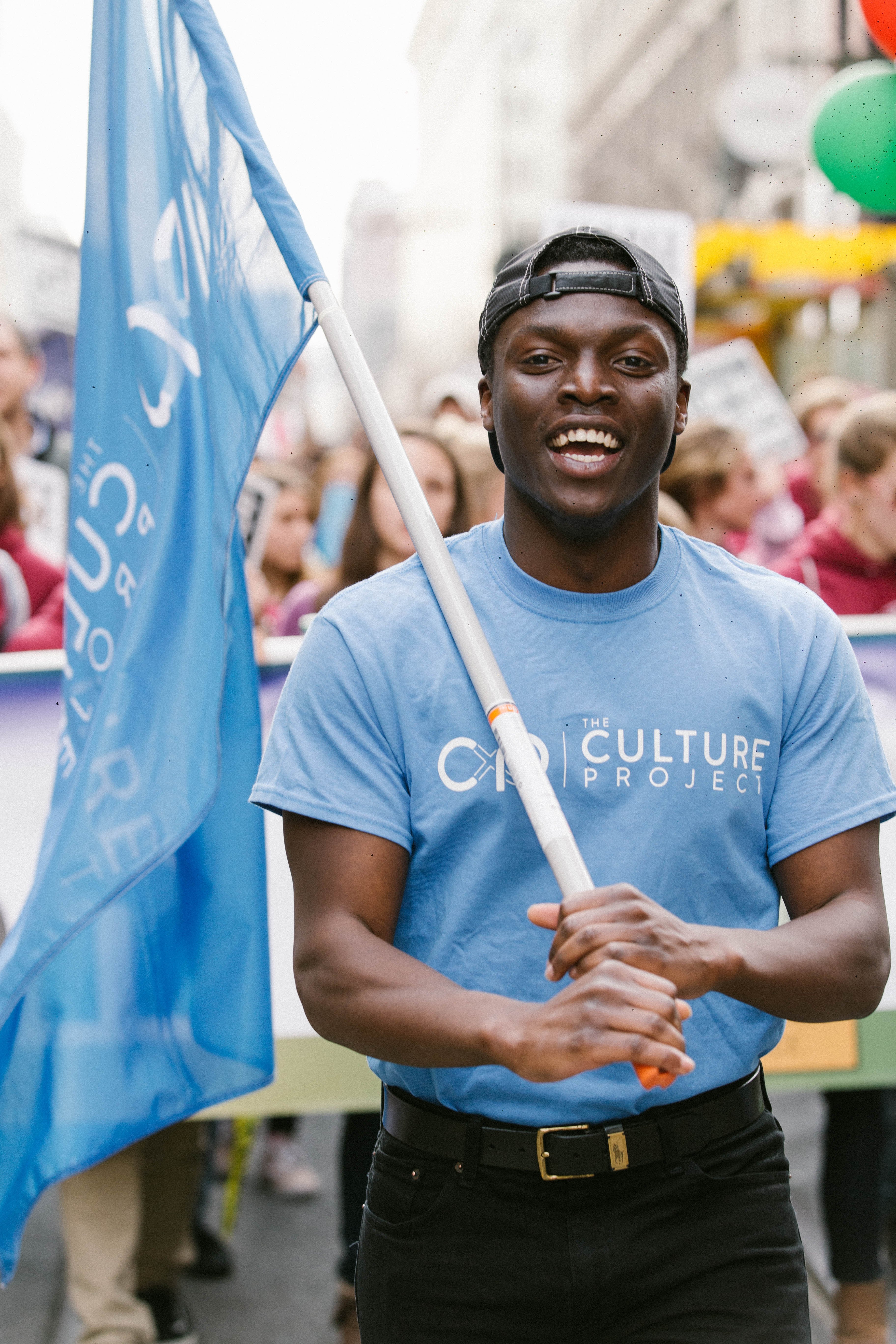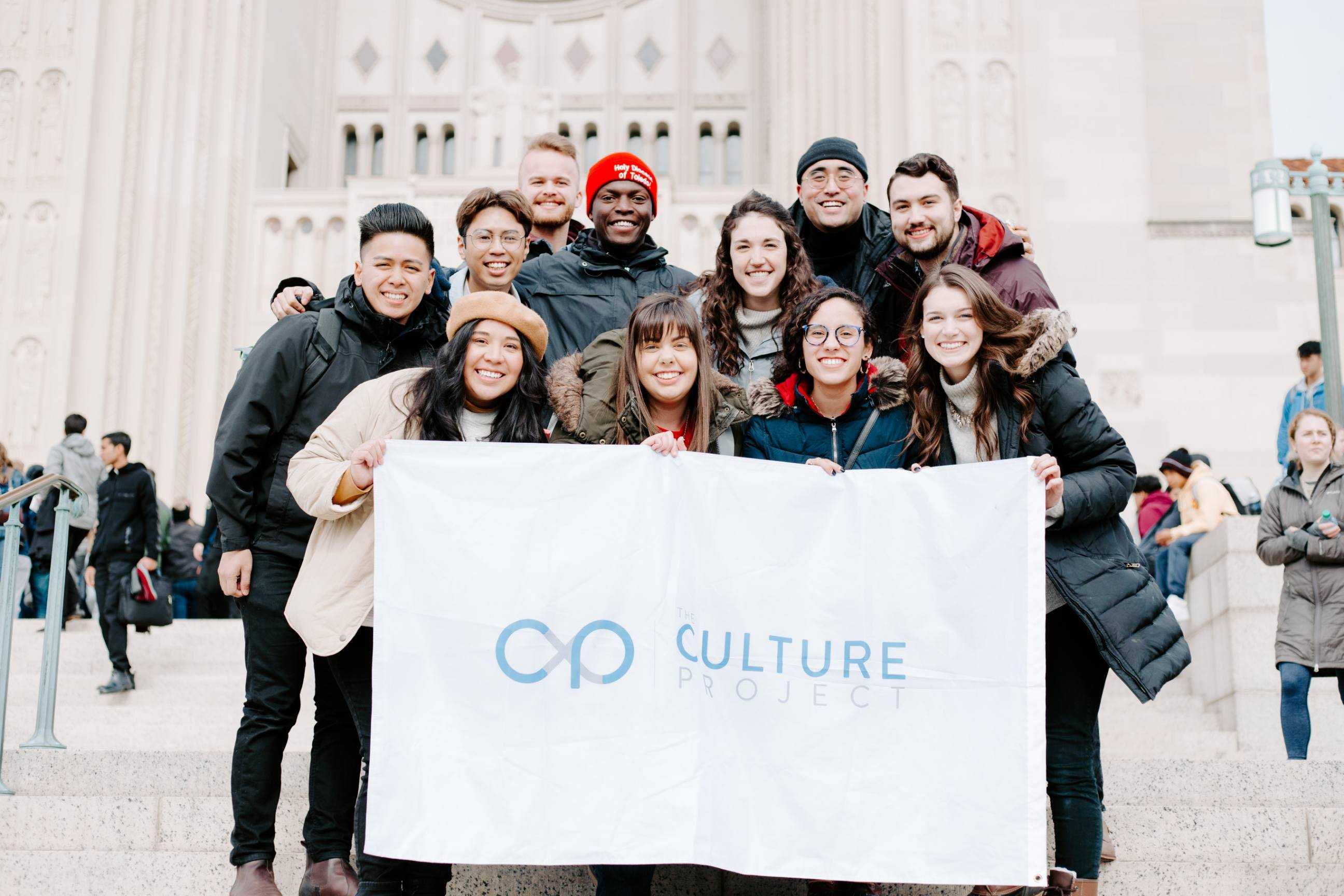
Laura Range interviews a dynamic international ministry committed to inspiring and equipping your teenagers to live the life they were meant to live.
My diocese has been incredibly blessed to have hosted a team of Culture Project Missionaries for the past five school years. Each year I enjoy getting to know the new missionaries and learn their stories as well as hearing how they are impacting the students and young adults in our area to live out God’s plan for their lives with virtue, chastity, and true joy. Recently I was able to “virtually sit down” with Lauren Sabatka, The Culture Project’s Director of Strategic Partnerships, and ask her a few questions about the Culture Project and how to help parents raise holy teenagers -- because yes, those two words can absolutely go together!
(Laura Range for CatholicMom.com) Can you share with our readers about the mission and purpose of the Culture Project?
(Lauren Sabatka for The Culture Project) The Culture Project is an initiative of young people, set out to restore culture by proclaiming the inherent dignity of the human person and the richness of living sexual integrity. Our missionaries serve in dioceses across the country, delivering presentations to teens, college students and young adults in middle schools, high schools, conferences and parish settings, as well as engaging culture through dialogue, friendship and the witness of our lives.
There is an urgent need for this outreach. We find ourselves inundated by dehumanizing messages, industries, and behaviors rooted in a widespread misunderstanding of identity and sexuality. And in one form or another, we have all been affected by this culture of death -- a culture that views the human person as dispensable and of arbitrary significance. We’ve found the promises of this throwaway culture to be empty and unfulfilling. But we believe there’s more to the human story. There’s another way.
And so, at The Culture Project we are rising to create a society more beautiful through the humanizing power of virtue, particularly the virtue of chastity. We envision a world where human flourishing is fostered in the context of strong relationships and strong families; we dream of a world where the beauty of our sexuality is upheld and love is not cheapend by ugly counterfeits. This vision is the driving force behind our program and outreach. Our missionaries, all recent college graduates, commit to at least one year of intentional community life, in which they go to daily mass, pray together, receive ongoing formation, and go out to engage the culture.
Through our presentations, encounters, mentorship, resources and social media presence, we share with young people the splendor of who they are and what they are made for, inviting them to become fully alive.
Why is The Culture Project's message more than (although certainly including) the "save sex for marriage" message often given to the previous generation?
We offer young people a positive message of hope and freedom: They are worthy of so much more than what is being “sold” to them by the culture. They are worthy of a life of greatness, of a love that satisfies their deepest desires. Through being honest about our own stories and experiences, we get to share that chastity is the path to finding this love.
Unfortunately, in the past, chastity has been packaged as rules, restrictions, repression. But chastity is not “just saying no” - that’s abstinence. Certainly, chastity involves saving sex and sexually intimate acts for marriage because sex communicates the vows of marriage. This is one aspect of the virtue of chastity, which is actually an entire lifestyle of choosing greatness and authentic love. This lifestyle is a path to freedom and fulfillment for everyone, regardless of where they have been, what attractions they experience or what temptations they face.
Living chastity comes from the heart. It impacts what we watch, what we listen to, what we post and follow on social media, how we treat and speak to others, how we date, the boundaries we set in relationships and even how we dress. A chaste lifestyle entails some worthwhile sacrifices, similar to how an elite athlete must make a habitual decision to rise above the status quo in order to be free to achieve something truly noble. Choosing virtue every day is what makes us free.

What are some of the dangers facing teens and threatening their chastity that weren't as prevalent when their parents were growing up?
Teens today are living in the world of social media ... Young people are looking to social media for advice, answers, role models, affirmation, and a sense of belonging and identity.
A huge pitfall of social media that we address with teens is just how easy it is to access sexually explicit content through apps like Snapchat and Instagram. Snapchat’s Discover section has given kids instruction for how to have anal sex and how to hide internet activity from their parents... Pornography is no longer magazines found in your parent’s closet. It’s in the phone in your pocket, and it’s more violent, distorted and addictive than ever before. The largest consumers of porn are the 12-17 age group, who on average are first exposed by age 11 if not earlier. Teens’ understanding of sex and relationships is increasingly informed by porn. Porn rewires the brain to objectify persons and to crave porn -- and increasingly hardcore porn - more than real, human relationships. Porn kills love, destroys marriages, fuels sex trafficking and warps our understanding of the dignity of the human person … but the cultural narrative is that porn is harmless and even healthy.
Related to the pornography crisis is the epidemic of sexting we are seeing today. In pretty much every school we visit, students confide that they feel pressured into sexting, the sending and receiving of sexually explicit photos and/or videos. In essence, sexting involves using one’s own body as a form of pornography. 1 in 7 teens are sending sexts and 1 in 4 are receiving them.
And last, but certainly not least, I would say the breakdown of the family is so much more of a cultural threat today. Models of faithful, committed, chaste, sacrificial love are rare. Young people are starved of witnesses to healthy friendship, dating, chivalry and marriage. Many of them doubt whether real love is even possible.
Romans 5:20 says "where sin increased, grace overflowed all the more." What are some ways the Church and ministries like The Culture Project have risen to meet the greater need for combating these dangers?
[Culture Project missionaries] go into schools and parishes across the country to inspire young people with the hope that real love is possible and lifegiving. We reclaim the splendor of the human person, the profound meaning of sex and the richness of a love that requires sacrifice.
Our mission is not to condemn or lecture anyone, but rather to offer compassion and mercy. Our goal is to meet them where they are, and help them realize their own dignity and potential for unfathomable greatness. We challenge young people to question what they are being offered by the culture. At the end of the day, is it really what we want?
Thankfully, The Culture Project is not alone whatsoever in our grandiose mission! Catholic speakers and influencers like Emily Wilson, Sarah Swafford, Leah Darrow, Jason and Crystalina Evert, Matt Fradd and Chris Stefanik have been examples to us of how to courageously share hope, joy and truth with an aching world.
Our missionaries connect teens to organizations like Fight the New Drug, which exposes the proven harmfulness of pornography, the A21 Campaign against human trafficking, and Hope after Abortion. Other groups, like Integrity Restored , Covenant Eyes, Protect Young Minds and The Parenting Dare are equipping families and individuals with the tools they need to prevent & break free from pornography addiction. Protect Young Eyes, Common Sense Media and Plugged In Online offer internet safety information and helpful media reviews for parents.
Courage International and Eden Invitation are examples of apostolates offering resources and support for people who experience same-sex attractions.

What are some practical ways parents can stay connected to their teens and be a relevant influence to them?
Make matters of human sexuality part of an ongoing conversation in natural ways. Maybe you are helping your daughter shop for a prom dress, and you can remind her of how beautiful and sacred her body is, and how you want to help her choose a modest and classy dress, reflective of that. Or maybe you could remind your middle school son before a night out with his friend group, “Watch your language, but especially around young ladies -- you have the privilege and duty as a man of protecting and honoring women.”
Spend time listening to your child every day: What is important to him? What are her fears? What are her desires? What is going on at school and how is it affecting him? Cultivating an ongoing relationship of openness and trust will give your teen the freedom to be vulnerable. Be willing to take the initiative and raise “awkward” topics they might be too embarrassed to bring up. Simply encourage your child to share his or her questions, experiences, struggles -- and focus on reacting with love and gratefulness for their vulnerability, rather than with anger, scandal or shame. Instead of using fear tactics, focus on how chastity gives us the capacity to love and frees us to know if we are being loved or used.
We find that young men are often motivated by a desire for greatness and heroism; young women are often motivated by a desire to be loved, wanted and seen as beautiful. I would suggest helping your teen connect with these desires; help them see that a lifestyle of chastity and virtue offers them what they truly want.
Are there any special saints you recommend teens get to know?
Blessed Carlo Acutis. He was a 15-year-old computer geek who documented Eucharistic miracles, and his tomb was just opened for veneration. He’s wearing jeans, sneakers and a hoodie.
St. Thérèse of Lisieux and Padre Pio. St. Therese’s story is so ordinary, and Padre Pio’s is so unbelievably wild and outrageous (he could read souls and bilocate). Talking about the two in tandem is fascinating for teens.
Saint José Luis Sánchez del Rio (“Joselito”), a powerful example of youth, bravery and faith who died a martyr at age 14.
Blessed Chiara Badano, a teen girl who loved sports, music and saw Jesus in the face of the sick and outcast. She endured cancer and paralysis with a heart full of love. Her story teaches us the power of redemptive suffering and surrender to God’s plan.
Blessed Pier Giorgio Frassati, who loved mountain climbing, had a heart for the poor, and led his friends closer to Jesus through the mass, Rosary and Scripture.
Can you share some of your resources for both parents and teens?
The Culture Project offers resource videos on our YouTube channel for parents. I’d recommend checking out our Chastity and Keeping It Real playlists. We also have a super helpful video for parents that shares 5 Tools for Keeping Kids Safe online. Parents and teens can find us on social media on Instagram and Facebook.
The Culture Project offers a Parent Presentation to share more about our mission, empower parents as the primary educators of their children, and to offer more insights into the content of our talks.
Copyright 2020 Laura Range
Images courtesy of The Culture Project: (top to bottom) copyright 2020 Brian Ngyuen; copyright 2020 David Sao; copyright 2020 Brian Nguyen
About the Author

Laura Range
Laura Range is an RN-turned-SAHM living in rural Ohio. A wife and mother of 5 (plus one in heaven), she is passionate about marriage and family life, redeeming the culture, and cultivating community. She enjoys cooking (and eating) tasty food, crafting and DIY, good books, little moments, and keeping it real. She runs a local miscarriage ministry and blogs at Life is Beautiful.


.png?width=1806&height=731&name=CatholicMom_hcfm_logo1_pos_871c_2728c%20(002).png)
Comments